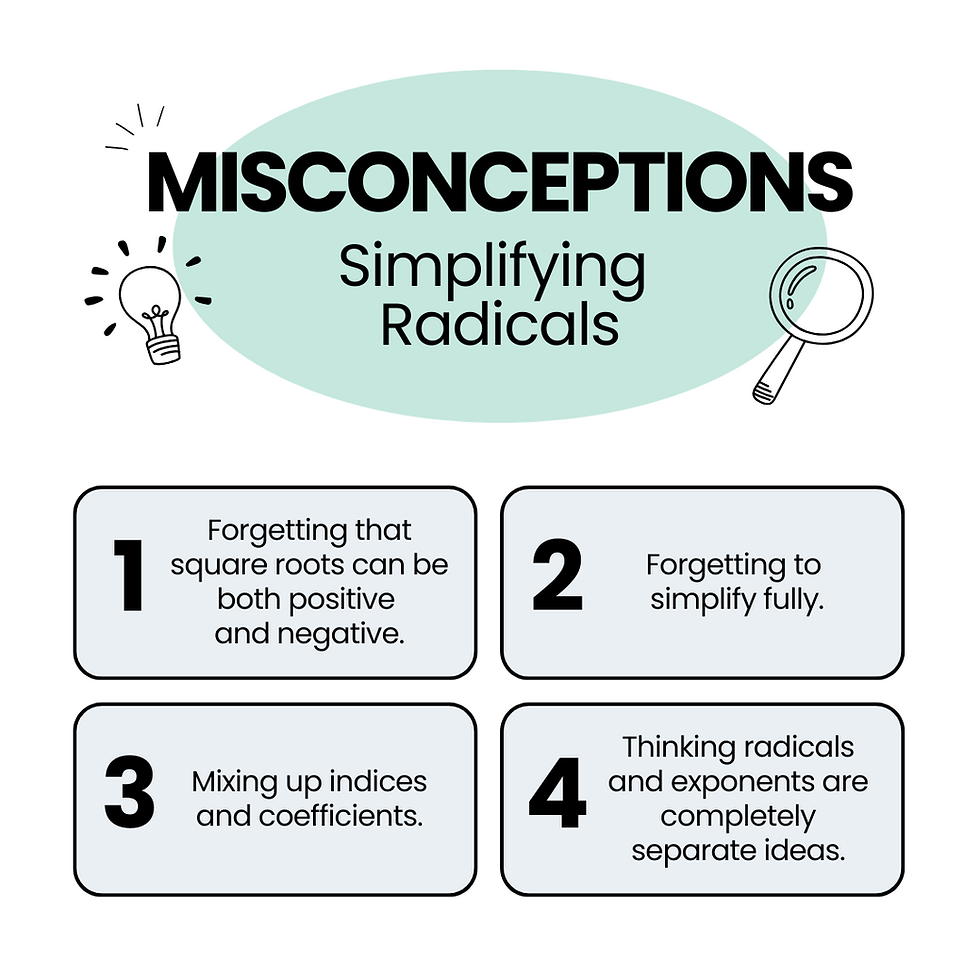Rational Exponents - Misconceptions
- Hazel Learning

- Aug 28
- 3 min read
Students struggle with understanding and applying the rules of exponents once fractions enter the notation system. These misunderstandings often persist into higher education and even among preservice teachers. This article explores four widespread misconceptions - identified in mathematics education - and examines why they occur from a cognitive and conceptual standpoint.

“Different denominators in exponents can’t be combined”
One frequently observed error is the belief that rational exponents with unlike denominators cannot be added or subtracted. For example, students often resist simplifying expressions such as:
Instead, they may claim the operation is undefined or requires an entirely different rule. Research shows that this misconception is strongly tied to difficulties with fraction arithmetic in general. When algebraic symbols conceal fraction operations, students lose the intuitive connection to previously learned numerical skills. Many learners compartmentalize fractions and exponents as separate topics, leading to errors when the two are integrated.
In effect, students perceive denominators as barriers rather than representations of root order. This reflects a broader challenge: students often treat mathematical symbols in isolation rather than as parts of a coherent system.
“Rational exponents are approximate, not exact”
Another misconception concerns the supposed “approximate” nature of fractional exponents. Learners sometimes argue that expressions rasied to fractional powers are estimates, not precise answers.
This belief appears to stem from the association of roots with irrational or nonterminating decimals. For instance, the square root of 2 has no finite decimal expansion, so students generalize this uncertainty to all root operations. Students often apply overgeneralized intuitive rules in place of rigorous reasoning, especially when confronting less familiar symbolic expressions.
Many secondary students view roots as operations that inevitably produce decimals rather than exact algebraic results. This tendency is compounded by the heavy reliance on calculators in school mathematics, where roots are typically presented in decimal form, reinforcing the perception of approximation. Thus, the misconception reveals not only a symbolic difficulty but also a deeply embedded epistemological stance: that certain operations inherently yield “inexact” answers.
“Negative fractional exponents are not allowed”
A third misconception concerns negative rational exponents. Students frequently avoid or reject expressions with negative and rational exponents at the same time, regarding them as undefined or meaningless. This error highlights the compartmentalization of concepts. Preservice teachers often treat negative exponents, roots, and reciprocals as unrelated ideas, failing to synthesize them into a single framework.
Moreover, negative signs are cognitively overloaded in mathematics, often signifying direction, subtraction, or inversion. Such overloading creates confusion in algebra, where the same symbol carries multiple abstract meanings. For fractional exponents, the negative is supposed to denote a reciprocal, but learners may default to earlier, less abstract interpretations of the symbol. This misconception illustrates how notational overload and fragmented learning histories can converge to block students’ understanding of rational exponents.
“Rational powers can’t be raised to another power”
A final widespread error is the belief that the power-of-a-power law does not extend to rational exponents. Learners often hesitate to simplify the following expressions, even though the rule applies universally:
This misconception reflects a lack of “operational-symbolic duality.” Students may see exponents purely operationally - as instructions for repeated multiplication - but fail to recognize the structural properties of exponents that persist across different representations. As a result, once the base rule of “multiply powers” becomes obscured by fractional notation, the student concludes that the rule no longer holds.
The notion of the “concept image” is also useful here. A student’s concept image of exponents often centers on whole numbers, leaving rational exponents outside their mental model. When asked to apply exponent laws in unfamiliar cases, they may incorrectly believe the rule ceases to function.
Summary
Rational exponents encapsulate roots and powers within a unified algebraic system, but their compact notation conceals multiple layers of meaning. Students struggle with four major misconceptions:
Believing exponents with different denominators cannot be combined.
Viewing fractional exponents as approximate, not exact.
Rejecting negative rational exponents as invalid.
Assuming exponent laws cannot extend to rational exponents raised to powers.
These misconceptions are not trivial mistakes but reveal deeper challenges in symbol interpretation, concept integration, and epistemological framing. Understanding the roots of these errors is crucial for designing effective pedagogy - though the strategies for teaching will be the subject of a subsequent article.



Comments